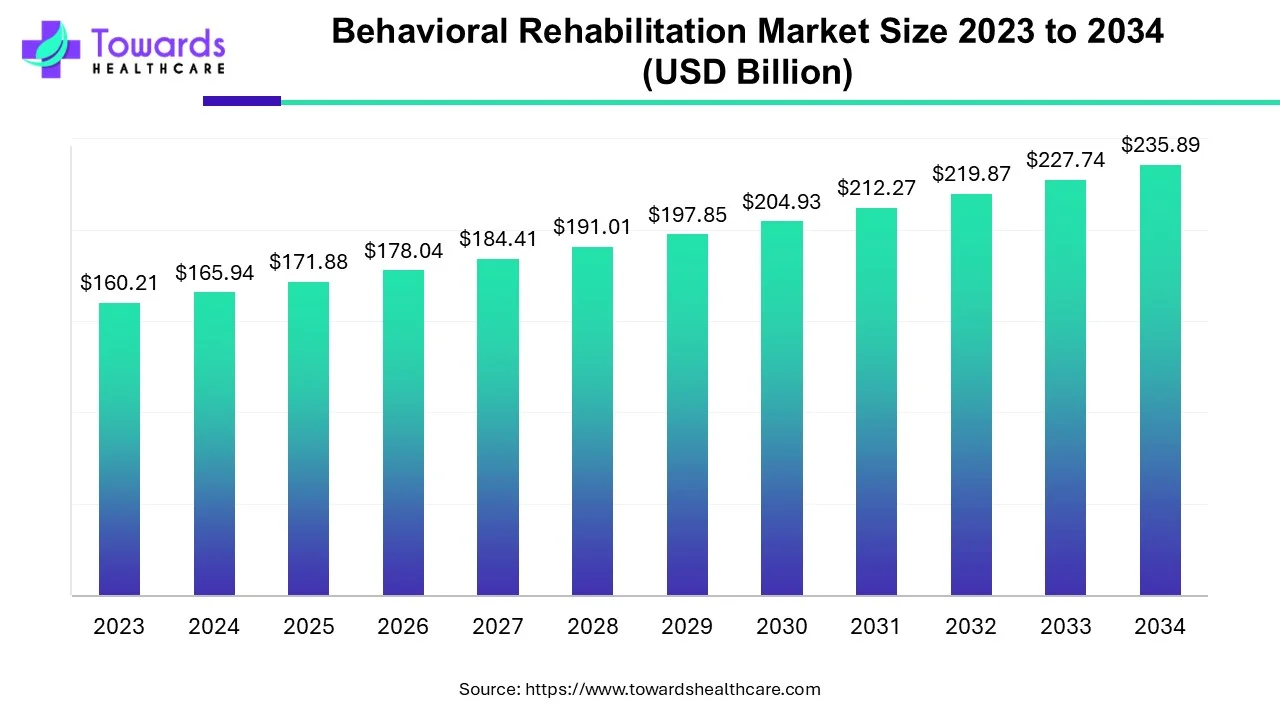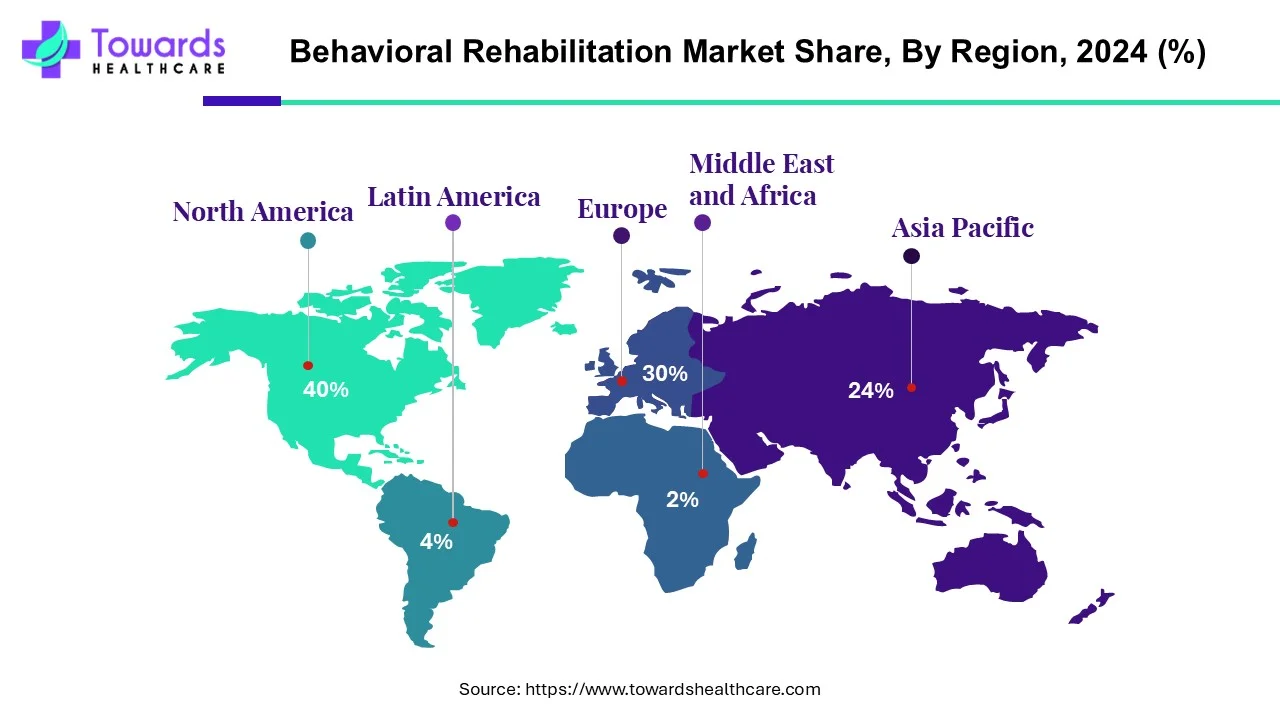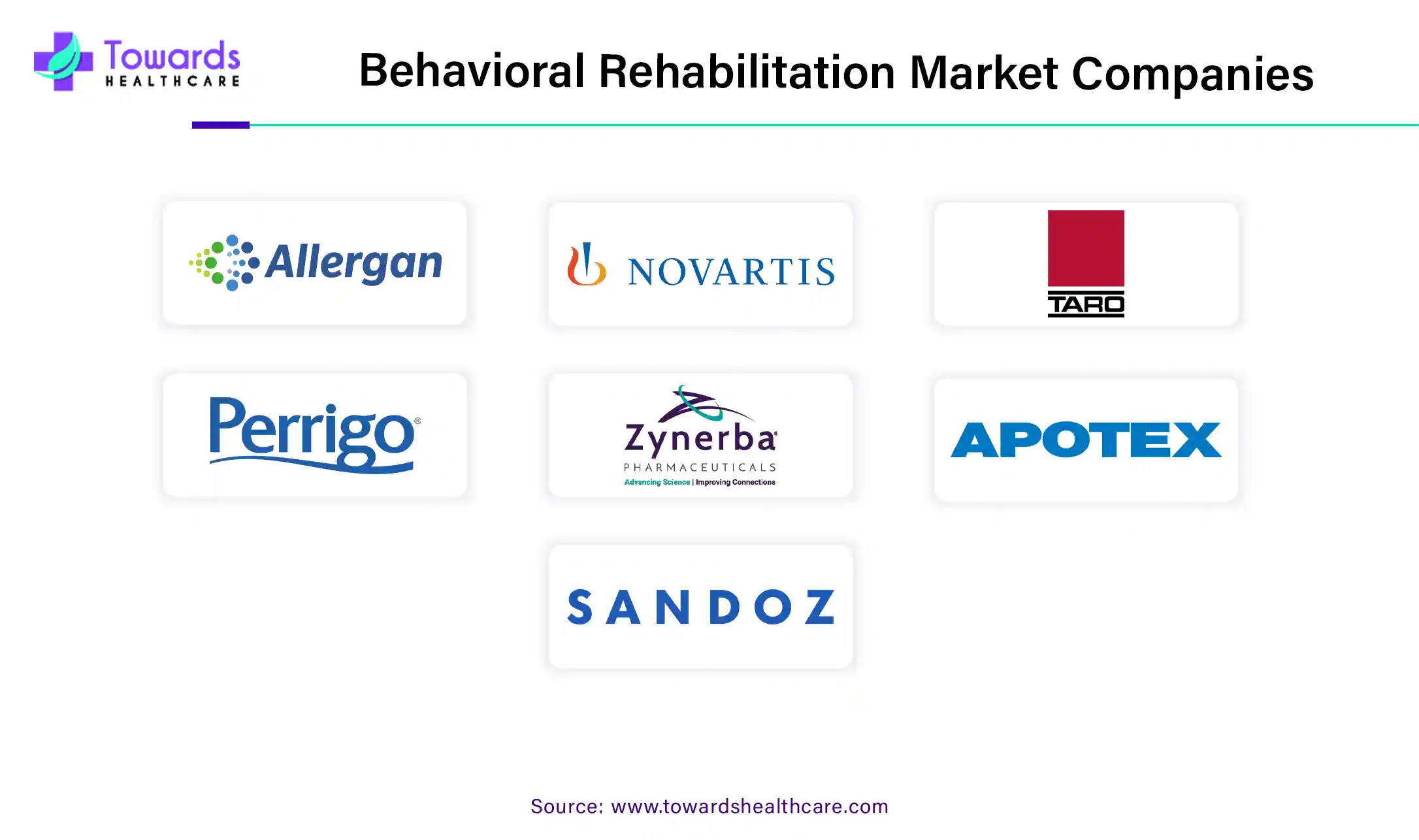October 2025

The global behavioral rehabilitation market is expected to increase from USD 171.88 billion in 2025 to USD 235.89 billion by 2034, growing at a CAGR of 3.58% throughout the forecast period from 2025 to 2034.

| Metric | Details |
| Market Size in 2024 | USD 165.94 billion |
| Projected Market Size in 2034 | USD 235.89 Billion |
| CAGR (2025 - 2034) | 3.58% |
| Leading Region | North America |
| Market Segmentation | By Disorder Type, By Application and By Region |
| Top Key Players | Allergan, Inc., Novartis AG, Taro Pharmaceutical Industries, Perrigo Company plc, Zynerba Pharmaceuticals, Apotex Inc., Sandoz AG, Strides Arcolab Ltd., TOLMAR Pharmaceuticals, Inc., Limbix. |
Behavioral rehabilitation is a psychotherapy strategy used to treat certain learned behaviors that are harmful to an individual's well-being. It entails the prescription of psychotherapy, medicine, and various support services, such as reinforcement, punishment, and modeling, to change an individual's psychological conditioning and reduce the occurrence of self-destructive and unhealthy behaviors.
After an acquired brain injury, behavior rehabilitation focuses on changes in how people feel and express themselves. Behavioral rehabilitation teaches people how to manage inappropriate behaviors that may cause issues with family members, friends, coworkers, and others. It is intended to develop a new intervention that will prevent new mood episodes and only prevent new mood episodes but will also improve memory, attention, executive functioning, and quality of life.
Integration of an augmented-reality headset in the treatment of Parkinson's led to an improvement in the patient's movement. This recent digital device for enhancing posture and walking in patients with Parkinson's disease, according to a clinical trial at the Cleveland Clinic. Augmented reality, or AR, permits patients to complete digital programs projected into the world around them. Physician also use their own AR headsets to immerse themselves in the reality of their patients by responding to their actions, which led to the growth of the behavioural rehabilitation market.
Artificial intelligence (AI) and machine learning (ML) algorithms play a vital role in transforming rehabilitation services. AI and ML can diagnose and detect a patient’s mental health conditions, increasing accuracy and precision in diagnostics. This enables healthcare professionals to make informed clinical decisions. They can also suggest effective rehabilitation treatment strategies and predict outcomes, reducing manual errors. The advent of AI-based virtual reality systems using AI chatbots has shown promising results in providing accessible support. This helps patients and healthcare providers to maintain data privacy and confidentiality. AI-based wearable devices and mobile apps provide at-home rehabilitation services to patients, enabling them to perform exercises and track their progress. Thus, healthcare professionals can customize treatment plans based on patients’ progress.
The rising prevalence of behavioral disorders is propelling the industry forward. The frequency of behavioral problems and addictions has increased as a result of technological advancements and fast urbanization, particularly among young adults aged 16 to 25. One of the primary causes of the rise in behavioral problems is the easy availability of harmful substances. Addiction to gaming, online gambling, and pornography has grown in tandem with the internet's increasing penetration. As a result, the rising frequency of behavioral disorders is generating unmet demand, which will drive industry expansion throughout the projection period.
People's perceptions about behavioral rehabilitation are changing, which is fueling the global expansion of the behavioral rehabilitation industry. The public or societal acceptance of behavioral disorders has increasingly increased, inspiring people to seek treatment for behavioral addictions. Individuals suffering from behavioral disorders are no longer afraid to communicate their psychological health issues, which is driving the acceptance of behavioral rehabilitation treatment alternatives.
The impact of stigma on people with behavioral disorders is projected to hinder the global behavioral rehabilitation market's expansion. The stigma associated with behavioral disorders, for instance, has a detrimental influence on people and directly impacts individuals and their families. Social stigma and discrimination can exacerbate mental health issues and prevent people from seeking care. Furthermore, stigma can inhibit people with mental illnesses from seeking treatment, sticking to treatment regimens, and functioning productively in communal settings.
People's lack of understanding of behavioral problems is projected to obstruct the global behavioral rehabilitation industry's expansion. For instance, behavioral disorders involve a pattern of disruptive actions that are frequently difficult to diagnose due to a lack of awareness. According to Mental Health America (mahanatinal.org), the number of persons with a mental disease who have unmet treatment needs has climbed every year since 2011.
The industry development is being also hindered by a shortage of patient enrollment. Many people are afraid to seek treatment for addictions and behavioral problems, which is hampering the market growth. Low awareness about the consequences of addictions and a lack of information are two factors that influence patient enrollment in behavioral rehabilitation programs. Such factors may constrain industry expansion during the predicted period.
The introduction of online counseling (or telerehabilitation) is predicted to generate major growth prospects for behavioral rehabilitation industry participants. BHI-TWP will begin offering TeleBehavioral Health 301 and 401 courses in January 2022. The 301 series will emphasize how TeleBehavioral Health abilities can be utilized to improve the mental health of certain populations, as well as the development of TeleBehavioral-specific tools and protocols. The 401 series will bring together national experts from throughout the country to discuss highly relevant complicated topics surrounding the design and implementation of effective TeleBehavioral Health programs. The rising use of behavioral rehabilitation treatment methods is likely to provide lucrative growth prospects for global behavioral rehabilitation industry players.

The anxiety segment holds the major industry share of about 35% in 2022 and is expected to remain dominant throughout the projected time frame. Anxiety disorders are one of the most prevalent types of mental illnesses. Feelings of fear or dread, feeling tense or jumpy, restlessness or irritability, anticipating the worst, and being on the lookout for indicators of danger are some of their emotional manifestations. Factors such as increasing incidence and availability of behavioral rehabilitation therapies, as well as increased awareness, are projected to drive market expansion. Anxiety disorders are treatable, and there are various effective therapies available. Treatment enables the majority of people suffering from anxiety disorders to live normal and productive lives. This issue is increasing the demand for therapeutic solutions.
The substance abuse disorder segment, on the other hand, is expected to grow at a faster rate during the projected timeframe. This is due to the increased penetration of illegal companies and rising unemployment, which leads to drug addiction among people. Abuse of drugs is a key source of mental problems, and increased knowledge about this is expected to boost the expansion of this segment. Furthermore, the government's inability to combat the illegal drug trade, particularly in developing and poor countries, is predicted to increase the number of drug users, fueling demand for behavioral rehabilitation services around the world. Rising substance abuse awareness and the social acceptability of rehabilitated patients are major factors driving the demand for rehabilitation services. In addition to these factors, increased government initiatives to combat substance misuse are predicted to drive the segment's growth at the fastest rate during the projection period.

The outpatient segment holds the major industry share in 2022 and is expected to remain dominant throughout the projected time frame owing to the benefits it delivers to patients. Outpatient treatment allows patients to return home after routinely attending treatment programs. Outpatient care is advantageous for people who are in the early stages of a mental health issue due to its flexibility. However, the treatment of substance misuse patients under this form of care is deemed ineffective. This happens because the patient can return to their home and friends after undergoing therapy and consuming narcotics.
The inpatient segment is anticipated to grow with the highest CAGR in the market during the studied years. Inpatient treatment or services are required for patients with a severe or late-stage behavioral disorder. Inpatient treatment offers advanced care through the availability of specialized equipment and the presence of trained professionals. A suitable infrastructure allows patients to recover faster and more efficiently.

North America holds a major industry share of more than 40% in 2024 and is expected to hold its dominant position over the projected timeframe. North America is characterized by the rising incidence of mental health disorders such as anxiety, depression, and attention deficit disorders. According to NAMI, one in every five US adults suffers from mental illness each year. By combining physical and behavioral patient data into a single record and providing integrated care, physicians can act as a catalyst for improved health outcomes for patients and communities. Growing public awareness of the availability of behavioral rehabilitation services, increased public awareness of mental health illnesses, rising government initiatives to spread public awareness of rehabilitation services, and increased consumer spending on healthcare. All of these are important reasons that have fueled the expansion of the behavioral rehabilitation industry in North America in recent years.
Asia Pacific, on the other hand, is estimated to be the fastest-growing industry during the projected timeframe. This is attributable to increased consumer awareness of mental problems, an increase in the number of rehabilitation clinics, increased consumer expenditure on healthcare, and rising rates of drug addiction among adolescents. The surge in illicit drug consumption among the young population is likely to drive market growth in the next years, as illicit drug use results in a variety of mental health conditions.
Favorable government policies to increase awareness and promote behavioral rehabilitation in their respective nations also contribute to market growth. In recent years, the Chinese government has increased its support for the development of community-based psychiatric rehabilitation services and initiated pilot programs.
In September 2023, Discovery Behavioral Health, Inc. and Videra Health launched Discovery365, an AI-driven platform to track patient’s progress for 12 months after discharge from a behavioral treatment program. Brett Talbot, Chief Clinical Officer of Videra Health, commented that integrating AI into this platform will significantly advance solutions for the betterment of patients everywhere, enabling greater insight into a patient’s journey.
The industry is moderately fragmented with various local players present. These participants are attempting to increase their market share through techniques such as investments, collaborations, acquisitions, and mergers. Companies are also investing in the development of new products. Furthermore, they are concentrating on keeping competitive pricing.

By Disorder Type
By Application
By Geography
October 2025
October 2025
October 2025
October 2025